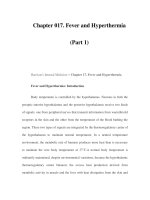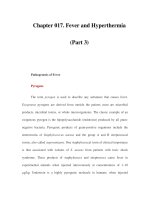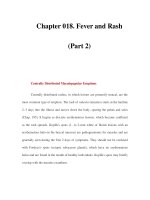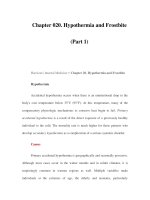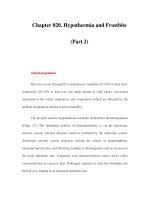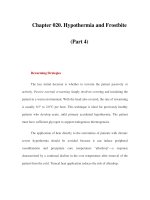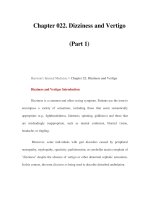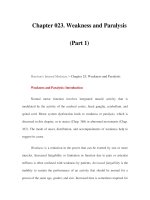Chapter 053. Eczema and Dermatitis (Part 1) pot
Bạn đang xem bản rút gọn của tài liệu. Xem và tải ngay bản đầy đủ của tài liệu tại đây (12.31 KB, 5 trang )
Chapter 053. Eczema and
Dermatitis
(Part 1)
Harrison's Internal Medicine > Part 2. Cardinal Manifestations and
Presentation of Diseases > Section 9. Alterations in the Skin > Chapter 53.
Eczema, Psoriasis, Cutaneous Infections, Acne, and Other Common Skin
Disorders > Eczema and Dermatitis
Eczema and Dermatitis: Introduction
Eczema is a type of dermatitis and these terms are often used
synonymously (atopic eczema or atopic dermatitis). Eczema is a reaction pattern
that presents with variable clinical findings and the common histologic finding of
spongiosis (intercellular edema of the epidermis). Eczema is the final common
expression for a number of disorders, including those discussed in the following
sections. Primary lesions may include erythematous macules, papules, and
vesicles, which can coalesce to form patches and plaques. In severe eczema,
secondary lesions from infection or excoriation, marked by weeping and crusting,
may predominate. In chronic eczematous conditions, lichenification (cutaneous
hypertrophy and accentuation of normal skin markings) may alter the
characteristic appearance of eczema.
Atopic Dermatitis
Atopic dermatitis (AD) is the cutaneous expression of the atopic state,
characterized by a family history of asthma, allergic rhinitis, or eczema. The
prevalence of AD is increasing worldwide. Some of its features are shown in
Table 53-1.
Table 53-1 Clinical Features of Atopic Dermatitis
1. Pruritus and scratching
2. Course marked by exacerbations and remissions
3. Lesions
typical of eczematous dermatitis
4. Personal or family history of atopy (asthma, allergic rhinitis,
food allergies, or eczema)
5. Clinical course lasting longer than 6 weeks
6. Lichenification of skin
The etiology of AD is only partially defined, but there is a clear genetic
predisposition. When both parents are affected by AD, >80% of their children
manifest the disease. When only one parent is affected, the prevalence drops to
slightly over 50%. Patients with AD may display a variety of immunoregulatory
abnormalities including increased IgE synthesis, increased serum IgE, and
impaired delayed-type hypersensitivity reactions.
The clinical presentation often varies with age. Half of patients with AD
present within the first year of life, and 80% present by 5 years of age. About 80%
ultimately coexpress allergic rhinitis or asthma. The infantile pattern is
characterized by weeping inflammatory patches and crusted plaques on the face,
neck, and extensor surfaces. The childhood and adolescent pattern is marked by
dermatitis of flexural skin, particularly in the antecubital and popliteal fossae (Fig.
53-1). AD may resolve spontaneously, but over half of all individuals affected as
children will have dermatitis in adult life. The distribution of lesions may be
similar to those seen in childhood; however, adults frequently have localized
disease, manifesting as lichen simplex chronicus or hand eczema (see below). In
patients with localized disease, AD may be suspected because of a typical personal
history, family history, or the presence of cutaneous stigmata of AD such as
perioral pallor, an extra fold of skin beneath the lower eyelid (Dennie's line),
increased palmar skin markings, and an increased incidence of cutaneous
infections, particularly with Staphylococcus aureus. Regardless of other
manifestations, pruritus is a prominent characteristic of AD in all age groups and
is exacerbated by dry skin. Many of the cutaneous findings in affected patients,
such as lichenification, are secondary to rubbing and scratching.

